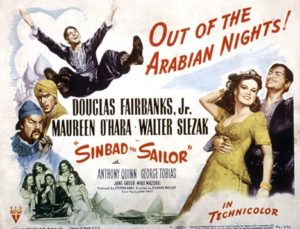Son of Monte Cristo
The Son of Monte Cristo
Rating: ***
Origin: USA, 1940
Director: Rowland V. Lee
Source: American Home Treasures DVD

Independent producer Edward Small’s biggest hit was The Count of Monte Cristo (1934) with star Robert Donat. Small planned to follow up with a sequel, but Donat bailed and went back to England, so the producer set the project aside until he found a charming new star in Louis Hayward. Sadly, this mediocre sequel doesn’t live up to its memorable predecessor, never really rising above Pretty Good. Much of the problem lies with screenwriter George Bruce’s story, a predictable cape-and-sword potboiler that’s more Anthony Hope (i.e., Zenda) than Alexandre Dumas, with a proto-fascist villain anachronistically thrown in for good measure.
At least the proto-fascist, General Gurko Lanen, is played by the lethally arrogant George Sanders, the only man in Hollywood who could out-sneer Basil Rathbone. The tale is set in 1865 in the fictional Balkan country of Lichtenburg, whose young ruler (Joan Bennett) is Grand Duchess Zona, a name that cannot be improved upon. Lanen and his jackbooted thugs threaten to usurp Zona’s power, so she attempts to escape to Paris to call for French intervention. Though her attempt is foiled, it’s stopped in a border incident that draws in the dashing Count of Monte Cristo—or his son, anyway, who now bears the title. Zona is taken back to Lichtenburg, and Monte Cristo, smitten, follows her.
The ensuing intrigues in Lichtenburg, though predictable, are entertaining enough, but the only thing Monte Cristo-ish about them is that the count adopts several guises and impersonations in his campaign to rescue Zona and her grand duchy from Gurko Lanen. The film plays genre-convention bingo by checking off secret passages, a masked outlaw, a grim castle dungeon, a fop with a quizzing glass, a secret treaty, a slimy sewer, a treacherous servant, forged documents, an interrupted wedding, and plenty of lively swordplay—nothing new here, but at least it’s enthusiastic. Hayward is likeable and energetic, Bennett is appealing and determined, and Sanders steals his every scene with sheer supercilious effrontery. Director Rowland V. Lee, who helmed the original, keeps the sequel moving along, and it’s a good time, mostly. Watch for Clayton Moore—yes, the Lone Ranger—as an earnest young guard captain loyal to Zona who allies with Monte Cristo.


